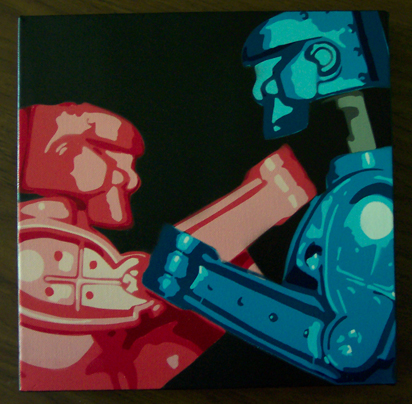Archive for January, 2017
With innovation you’ve got to feel worthy of the work.
 When doing work that’s new, sometimes it seems the whole world is working against you. And, most of the time, it is. The outside world is impossible to control, so the only way to deal with external resistance is to pretend you don’t hear it. Shut your ears, put your head down and pull with all your might. Define your dream and live it. And don’t look back. But what about internal resistance?
When doing work that’s new, sometimes it seems the whole world is working against you. And, most of the time, it is. The outside world is impossible to control, so the only way to deal with external resistance is to pretend you don’t hear it. Shut your ears, put your head down and pull with all your might. Define your dream and live it. And don’t look back. But what about internal resistance?
Where external resistance cannot be controlled and must be ignored, internal resistance, resistance created by you, can be actively managed. The best way to deal with internal resistance is to prevent its manufacture, but very few can do that. The second best way is to acknowledge resistance is self-made and acknowledge it will always be part of the innovation equation. Then, understand the traps that cause us to create self-inflicted resistance and learn how to work through them.
The first trap prevents starting. At the initial stage of a project, two unstated questions power the resistance – What if it doesn’t work? and What if it does work? If it doesn’t work, the fear is you’ll be judged as incompetent or crazy. The only thing to battle this fear is self-worth. If you feel worthy of the work, you’ll push through the resistance and start. If it does work, the fear is you won’t know how to navigate success. Again, if you think you’re worthy of the work (the work that comes with success), you and your self-esteem will power through the resistance and start.
Underpinning both questions is a fundamental of new work that is misunderstood – new work is different than standard work. Where standard work follows a well-worn walking path, new work slashes through an uncharted jungle where there are no maps and no GPS. With standard work, all the questions have been answered, the scope is well established and the sequence of events and timeline are dialed in. With standard work, everything is known up front. With new work, it’s the opposite. Never mind the answers, the questions are unknown. The scope is uncertain and the sequence of events is yet to be defined. And the timeline cannot be estimated.
But with so much standard work and so little new work, companies expect people to that do the highly creative work to have all the answers up front. And to break through the self-generated resistance, people doing new work must let go of self-imposed expectations that they must have all the answers before starting. With innovation, the only thing that can be known is how to figure out what’s next. Here’s a generic project plan for new work – do the first thing and then, based on the results, figure out what to do next, and repeat.
To break through the trap that prevents starting, don’t hold yourself accountable to know everything at the start. Instead, be accountable for figuring out what’s next.
The second trap prevents progress. And, like the first trap, resistance-based paralysis sets in because we expect ourselves to have an etched-in-stone project plan and expect we’ll have all the answers up front. And again, there’s no way to have the right answers when the first bit of work must be done to determine the right questions. If you think you’re worthy of the work, you’ll be able to push through the resistance with the figure out what’s next approach.
When in the middle of an innovation project, hold yourself accountable to figuring out what to do next. Nothing more, nothing less. When the standard work police demand a sequence of events and a timeline, don’t buckle. Tell them you will finish the current task then define the next one and you won’t stop until you’re done. And if they persist, tell them to create their own project plan and do the innovation work themselves.
With innovation, it depends. With innovation, hold onto your self-worth. With innovation, figure out what’s next.
Image credit — Jonathan Kos-Read
Diabolically Simple Prototypes
 Ideas are all talk and no action. Ideas are untested concepts that have yet to rise to the level of practicality. You can’t sell an idea and you can’t barter with them. Ideas aren’t worth much.
Ideas are all talk and no action. Ideas are untested concepts that have yet to rise to the level of practicality. You can’t sell an idea and you can’t barter with them. Ideas aren’t worth much.
A prototype is a physical manifestation of an idea. Where ideas are ethereal, prototypes are practical. Where ideas are fuzzy and subject to interpretation, prototypes are a sledge hammer right between the eyes. There is no arguing with a prototype. It does what it does and that’s the end of that. You don’t have to like what a prototype stands for, but you can’t dismiss it. Where ideas aren’t worth a damn, prototypes are wholly worth every ounce of effort to create them.
If Camp A says it will work and Camp B says it won’t, a prototype will settle the disagreement pretty quickly. It will work or it won’t. And if it works, the idea behind it is valid. And if it doesn’t, the idea may be valid, but a workable solution is yet-to-be discovered. Either way, a prototype brings clarity.
Prototypes are not elegant. Prototypes are ugly. The best ones do one thing – demonstrate the novel idea that underpins them. The good ones are simple, and the best ones are diabolically simple. It is difficult to make diabolically simple prototypes (DSPs), but it’s a skill that can be learned. And it’s worth learning because DSPs come to life in record time. The approach with DSPs is to take the time up front to distill the concept down to its essence and then its all-hands-on-deck until it’s up and running in the lab.
But the real power of the DSP is that it drives rapid learning. When a new idea comes, it’s only a partially formed. The process of trying to make a DSP demands the holes are filled and blurry parts are brought into focus. The DSP process demands a half-baked idea matures into fully-baked physical embodiment. And it’s full-body learning. Your hands learn, your eyes learn and your torso learns.
If you find yourself in a disagreement of ideas, stop talking and start making a prototype. If the DSP works, the disagreement is over.
Diabolically simple prototypes end arguments. But, more importantly, they radically increase the pace of learning.
Image credit – snippets101
With innovation, it depends.
 By definition, when the work is new there is uncertainty. And uncertainty can be stressful. But, instead of getting yourself all bound up, accept it. More than that, relish in it. Wear it as a badge of honor. Not everyone gets the chance to work on something new – only the best do. And, because you’ve been asked to do work with a strong tenor of uncertainty, someone thinks you’re the best.
By definition, when the work is new there is uncertainty. And uncertainty can be stressful. But, instead of getting yourself all bound up, accept it. More than that, relish in it. Wear it as a badge of honor. Not everyone gets the chance to work on something new – only the best do. And, because you’ve been asked to do work with a strong tenor of uncertainty, someone thinks you’re the best.
But uncertainty is an unknown quantity, and our systems have been designed to reject it, not swim in it. When companies want to get serious they drive toward a culture of accountability and the new work gets the back seat. Accountability is mis-mapped to predictability, successful results and on time delivery. Accountability, as we’ve mapped it, is the mortal enemy of new work. When you’re working on a project with a strong element of uncertainty, the only certainty is the task you have in front of you. There’s no certainty on how the task will turn out, rather, there’s only the simple certainty of the task.
With work with low uncertainty there are three year plans, launch timelines and predictable sales figures. Task one is well-defined and there’s a linear flow of standard work right behind it – task two through twenty-two are dialed in. But when working with uncertainty, the task at hand is all there is. You don’t know the next task. When someone asks what’s next the only thing you can say is “it depends.” And that’s difficult in a culture of traditional accountability.
An “it depends” Gannt chart is an oxymoron, but with uncertainty step two is defined by step one. If A, then B. But if the wheels fall off, I’m not sure what we’ll do next. The only thing worse than an “it depends” Gantt chart is an “I’m not sure” Gannt chart. But with uncertainty, you can be sure you won’t be sure. With uncertainty, traditional project planning goes out the window, and “it depends” project planning is the only way.
With uncertainty, traditional project planning is replaced by a clear distillation of the problem that must be solved. Instead of a set of well-defined tasks, ask for a block diagram that defines the problem that must be solved. And when there’s clarity and agreement on the problem that must be solved, the supporting tasks can be well-defined. Step one – make a prototype like this and test it like that. Step two – it depends on how step one turns out. If it goes like this then we’ll do that. If it does that, we’ll do the other. And if it does neither, we’re not sure what we’ll do. You don’t have to like it, but that’s the way it is.
With uncertainty, the project plan isn’t the most important thing. What’s most important is relentless effort to define the system as it is. Here’s what the system is doing, here’s how we’d like it to behave and, based on our mechanism-based theory, here’s the prototype we’re going to build and here’s how we’re going to test it. What are we going to do next? It depends.
What’s next? It depends. What resources do you need? It depends. When will you be done? It depends.
Innovation is, by definition, work that is new. And, innovation, by definition, is uncertain. And that’s why with innovation, it depends. And that’s why innovation is difficult.
And that’s why you’ve got to choose wisely when you choose the people that do your innovation work.
Image credit – Sara Biljana Gaon (off)
The Causes and Conditions for Innovation
 Everyone wants to do more innovation. But how? To figure out what’s going on with their innovation programs, companies spend a lot of time to put projects into buckets but this generates nothing but arguments about whether projects are disruptive, radical innovation, discontinuous, or not. Such a waste of energy and such a source of conflict. Truth is, labels don’t matter. The only thing that matters is if the projects, as a collection, meet corporate growth objectives. Sure, there should be a short-medium-long look at the projects, but, for the three time horizons the question is the same – Do the projects meet the company’s growth objectives?
Everyone wants to do more innovation. But how? To figure out what’s going on with their innovation programs, companies spend a lot of time to put projects into buckets but this generates nothing but arguments about whether projects are disruptive, radical innovation, discontinuous, or not. Such a waste of energy and such a source of conflict. Truth is, labels don’t matter. The only thing that matters is if the projects, as a collection, meet corporate growth objectives. Sure, there should be a short-medium-long look at the projects, but, for the three time horizons the question is the same – Do the projects meet the company’s growth objectives?
To create the causes and conditions for innovation, start with a clear growth objective by geography. Innovation must be measured in dollars.
Good judgement is required to decide if a project is worthy of resources. The incremental sales estimates are easy to put together. The difficult parts are deciding if there’s enough sizzle to cause customers to buy and deciding if the company has the chops to do the work. The difficulty isn’t with the caliber of judgement, rather it’s insufficient information provided to the people that must use their good judgement. In shorth, there is poor clarity on what the projects are about. Any description of the projects blurry and done at a level of abstraction that’s too high. Good judgement can’t be used when the picture is snowy, nor can it be effective with a flyby made in the stratosphere.
To create the causes and conditions for innovation, demand clarity and bedrock-level understanding.
To guarantee clarity and depth, use the framework of novel, useful, successful. Give the teams a tight requirement for clarity and depth and demand they meet it. For each project, ask – What is the novelty? How is it useful? When the project is completed, how will everyone be successful?
A project must deliver novelty and the project leader must be able to define it on one page. The best way to do this is to create physical (functional) model of the state-of-the-art system and modify it with the newness created by the project (novelty called out in red). This model comes in the form of boxes that describe the system elements (simple nouns) and arrows that define the actions (simple verbs). Think hammer (box – simple noun) hits (arrow -simple verb) nail (box – simple noun) as the state-of-the-art system and the novelty in red – a thumb protector (box) that blocks (arrow) hammer (box). The project delivers a novel thumb protector that prevents a smashed thumb. The novelty delivered by the project is clear, but does it pass the usefulness test?
To create the causes and conditions for innovation, demand a one-page functional model that defines and distills down to bedrock level the novelty created by the project. And to help the project teams do it, hire a good teach teacher and give them the tools, time and training.
The novelty delivered by a project must be useful and the project leader must clearly define the usefulness on one page. The best way to do this is with a one page hand sketch showing the customer actively using the novelty. In a jobs-to-be-done way, the sketch must define where, when and how the customer will realize the usefulness. And to force distillation blinding, demand they use a fat, felt tip marker. With this clarity, leaders with good judgement can use their judgement effectively. Good questions flow freely. Does every user of a hammer need this? Can a left-handed customer use the thumb guard? How does it stay on? Doesn’t it get in the way? Where do they put it when they’re done? Do they wear it all the time? With this clarity, the questions are so good there is no escape. If there are holes they will be uncovered.
To create the causes and conditions for innovation, demand a one-page hand sketch of the customer demonstrating the useful novelty.
To be successful, the useful novelty must be sufficiently meaningful that customers pay money for it. The standard revenue projections are presented, but, because there is deep clarity on the novelty and usefulness, there is enough context for good judgement to be effective. What fraction of hammer users hit their thumbs? How often? Don’t they smash their fingers too? Why no finger protection? Because of the clarity, there is no escape.
To create the causes and conditions, use the deep clarity to push hard on buying decisions and revenue projections.
The novel, useful, successful framework is a straightforward way to decide if the project portfolio will meet growth objectives. It demands a clear understanding of the newness created by the project but, in return, provides context needed to use good judgement. In that way, because projects cannot start without passing the usefulness and successfulness tests, resources are not allocated to unworthy projects.
But while clarity and this level of depth is a good start, it’s not enough. It’s time for a deeper dive. The project must distill the novelty into a conflict diagram, another one-pager like the others, but deeper. Like problem definition on steroids, a conflict must be defined in space – between two things (thumb and face of hammer head) – and time (just as the hammer hits thumb). With that, leaders can ask before-during-after questions. Why not break the conflict before it happens by making a holding mechanism that keeps the thumb out of the strike zone? Are you sure you want to solve it during the conflict time (when the hammer hits thumb)? Why not solve it after the fact by selling ice packs for their swollen thumbs?
But, more on the conflict domain at another time.
For now, use novel, useful, successful to stop bad projects and start good ones.
Image credit – Natashi Jay
 Mike Shipulski
Mike Shipulski